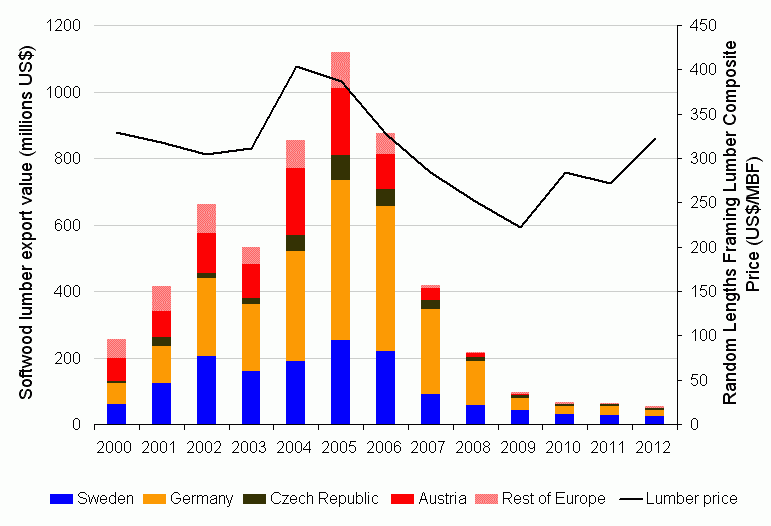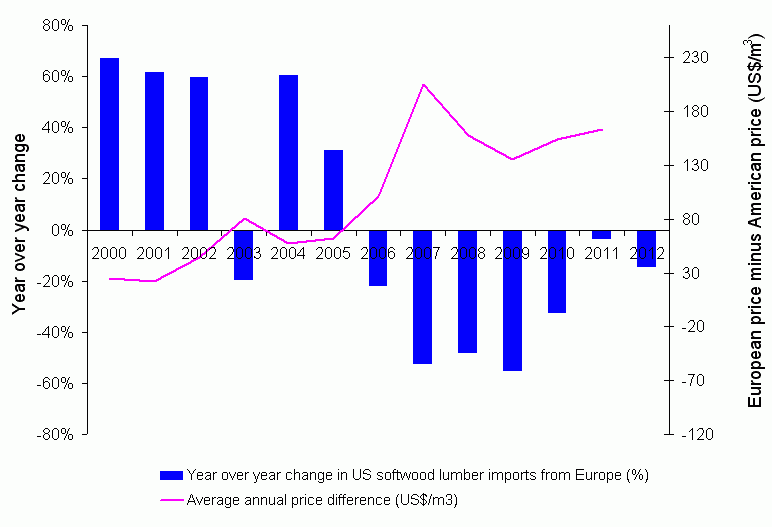Selective Cuttings
The role of price in European softwood lumber exports to the U.S.
July 5, 2013
Softwood lumber prices have steadily corrected since their lows in 2009, and U.S. demand is increasing, anchored to an improving housing sector. With the recent spike in prices to well over $400/MBF (now returning to more stable levels), the question arose as to whether European producers would once again start exporting into the U.S. market. In fact, a comparison between the first quarters of 2012 and 2013 shows that exports from Europe into the U.S. more than doubled, from 38,000 m3 to 93,000 m3.
The most frequently referenced hypothesis for what attracts European imports into the U.S. is high prices. A threshold of 450 US$/MBF is often quoted. However, that relationship is somewhat tenuous, since we can observe European lumber exports into the U.S. increasing even at prices well below 400$/MBF in some years, while also decreasing for similar or higher prices in other years (see Figure 1, between 2000 and 2006).
Figure 1. European softwood lumber exports into the United States in relation to North American softwood lumber prices.
Sources: Global Trade Atlas, Random Length
A more nuanced theory is that European producers increase exports to the U.S. when the difference between European and U.S. prices is small enough to become attractive. Lumber prices are traditionally higher in Europe where costs of production are higher. Transportation costs within Europe are often high, and the increased costs of shipping across the Atlantic are not as prohibitive as it might first be thought. With this thought in mind, there are at least three conditions that need to be met for European producers to increase shipments to the U.S.: (1) the price in the U.S. is high enough to generate a profit and (2) there is demand in the U.S. and (3) the European market has difficulty absorbing its own production (tepid demand and/or difficult shipping conditions across countries).
This story matches up more closely with the export trends observed (see Figure 2 below). Anecdotally, a price differential of about $70/m3 seems to have been a threshold that causes increases or decreases in export levels. Looking at Figure 1, the 2012 U.S. price of softwood lumber (322 US$/MBF) was similar to the price seen in 2001-2003, when much higher EU exports were taking place. However, Figure 2 shows why this is the case: in the early 2000’s the price differential was much more attractive for exports than in 2012. The higher prices in 2012 in NA have been matched with higher prices in the EU, reducing the export incentive.
Figure 2: European lumber exports into the US change as a function of the gap between EU and U.S. prices
Sources: Global Trade Atlas, Random Length, Swedish Wood Exporters Association
With very positive expectations for softwood lumber price and demand in the near future in the U.S. and tough market conditions in Europe, the price gap could narrow prompting further European softwood lumber imports into the U.S. later in 2013. However, this does not appear to be too large of a threat to Canadian producers. The high prices generally required to shrink the price differential with European prices are a boon to domestic production, and also it is unlikely that European imports will capture a large portion of the U.S. market. They have averaged only 3% over the past 20 years, and only once reached 10%.


